The Golden and Death Cross Moving Average Strategy
2025-07-23 12:54:18
Previous Lessons:
If you’re just joining the series, start here:
- Part 1: Moving Averages for Beginners
- Part 2: Best Moving Average Settings for Your Trading Style
- Part 3: How to Use Moving Averages as Dynamic Support and Resistance Zones
- Part 4: Simple Moving Average Strategy: For Entries, Exits, and Trend Confirmation
Goal of This Lesson

To break down the three most common moving average crossover strategies — the Golden Cross, Death Cross, and Triple MA Stack — so you can confidently use them to identify trends, catch reversals, and avoid false breakouts.
What is a Moving Average Crossover?
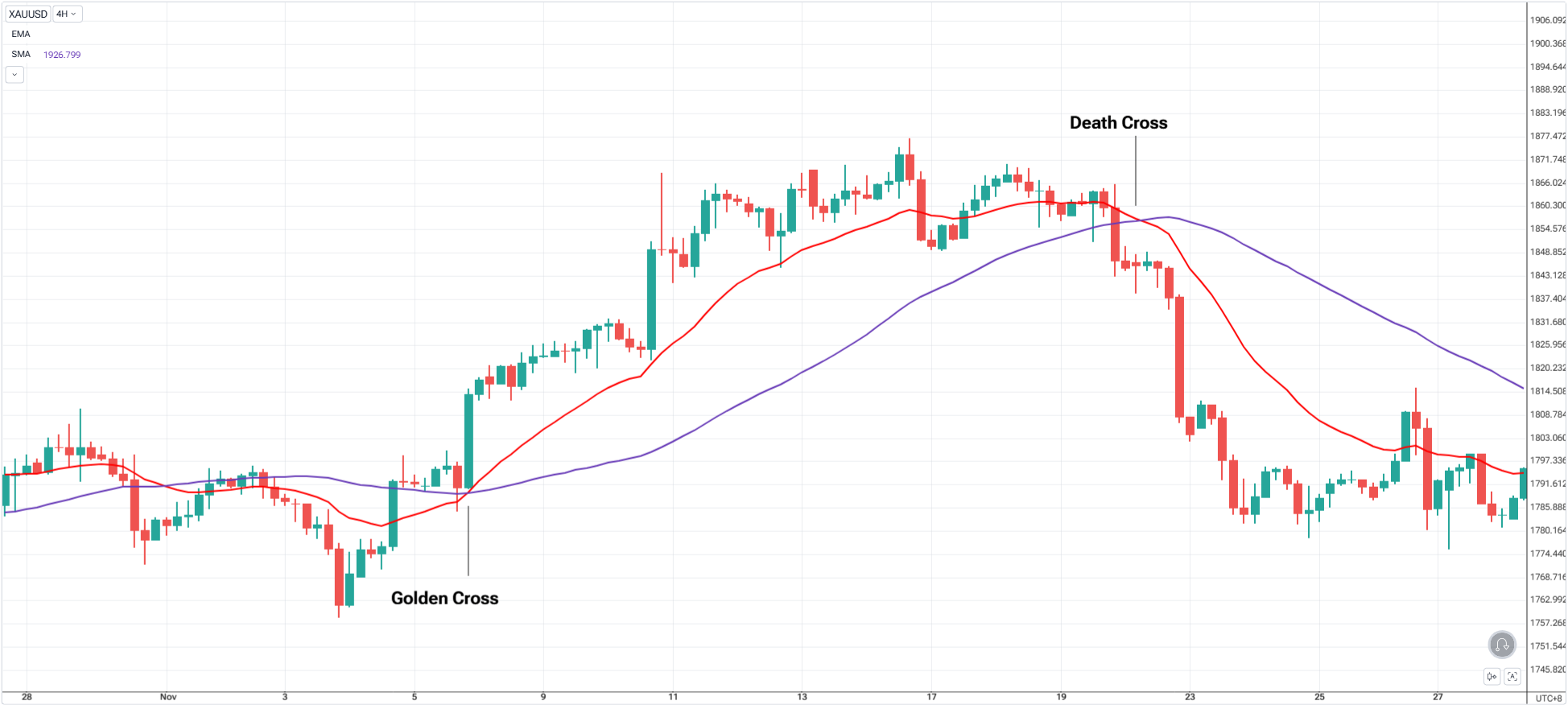
A moving average crossover occurs when a faster-moving average (like the 20 EMA) crosses above or below a slower one (like the 50 SMA). This creates a visual signal of trend momentum shifting — either accelerating or weakening.
Golden Cross: The Bullish Signal
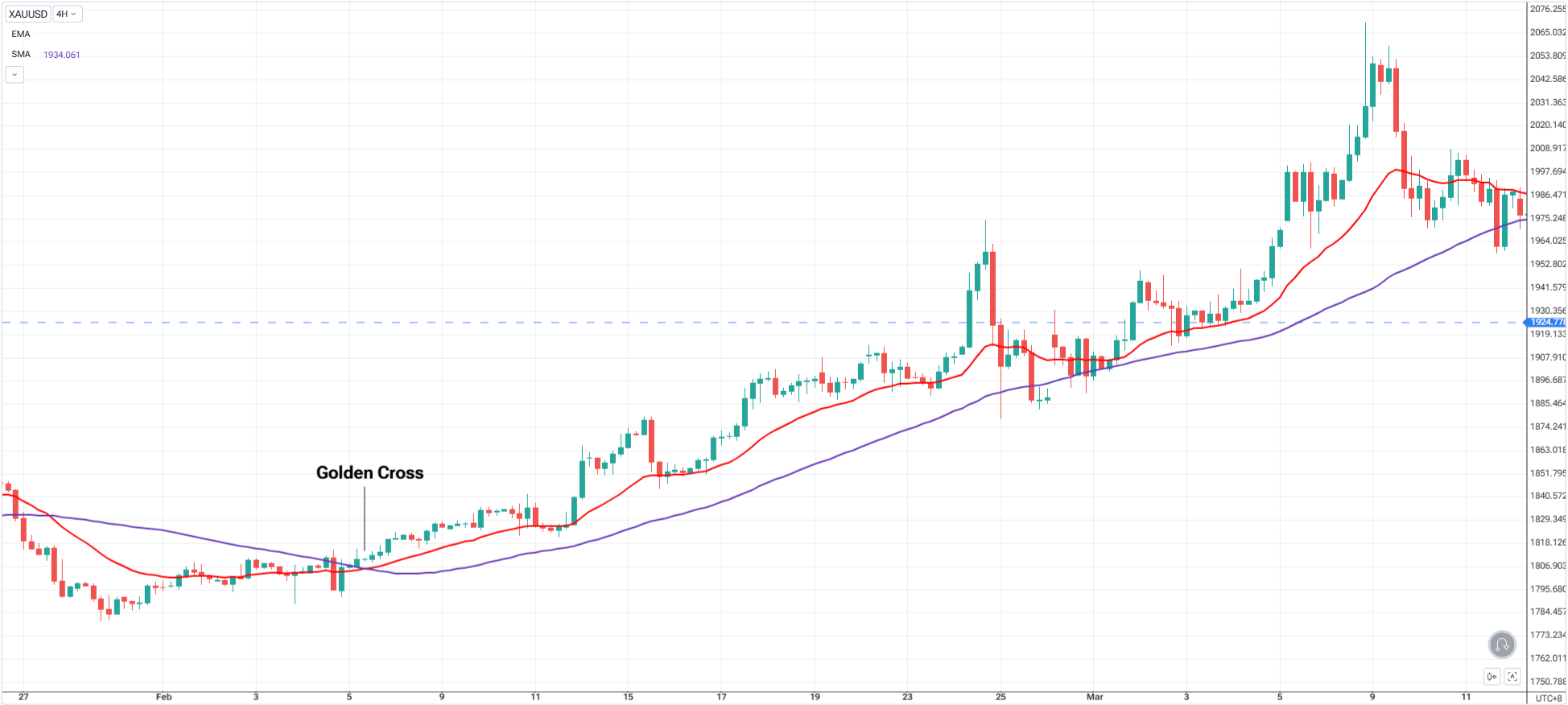
A Golden Cross happens when a shorter MA crosses above a longer MA (typically 50 SMA crossing above 200 SMA).
Death Cross: The Bearish Reversal
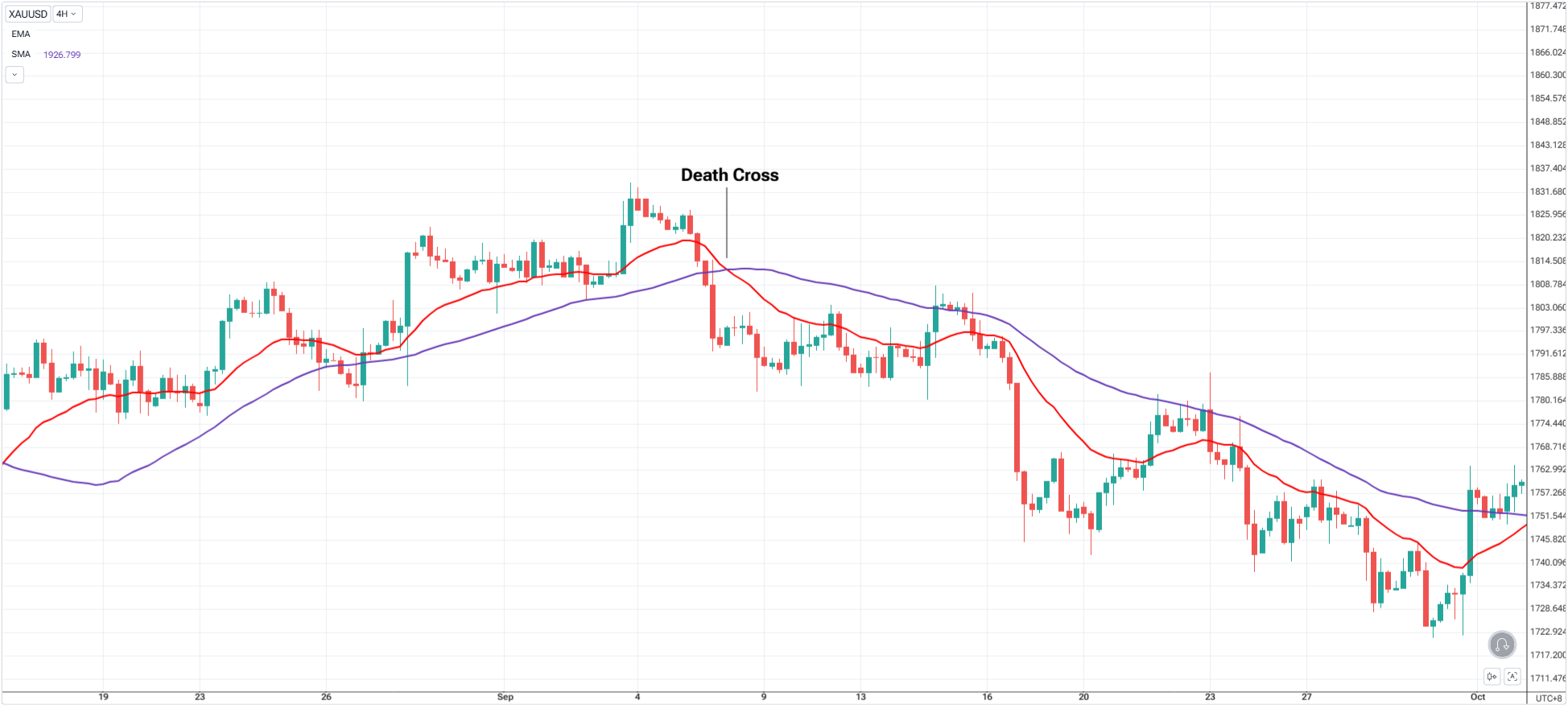
A Death Cross forms when a shorter MA crosses below a longer MA (e.g., 50 below 200), signaling potential long-term weakness.
How to Trade the Golden / Death Cross
Step 1: Mark the Current Price Action Range
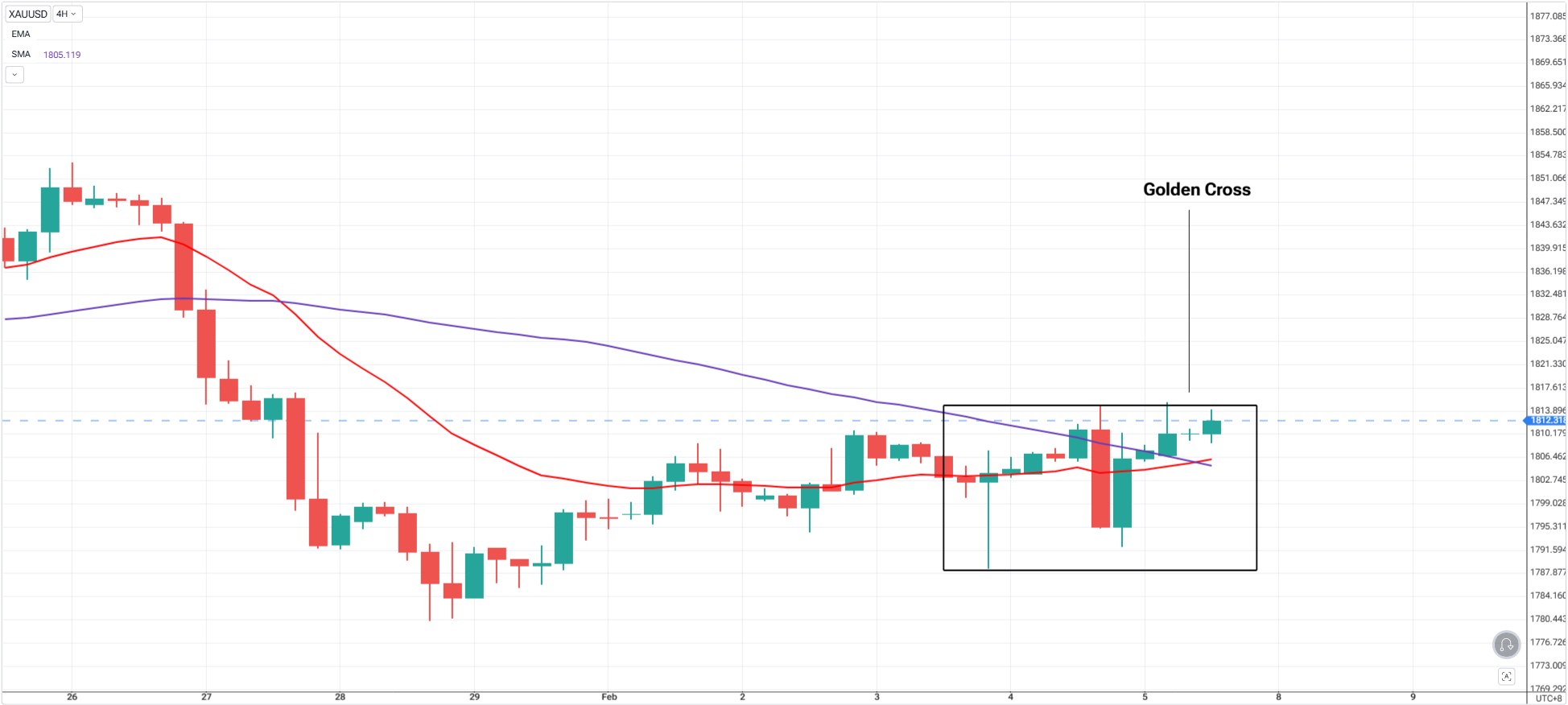
Mark the support and resistance levels that has not been tested yet.
Crosses usually occur when:
- Price is on a sideways range
- Transitioning from the previous trend to another
Note: We are not trading the actual cross immediately. The cross is our signal for a potential trend shift. Stay out. Wait for a price action confirmation.
Step 2: Wait for a Breakout + Pullback to the MA Zone
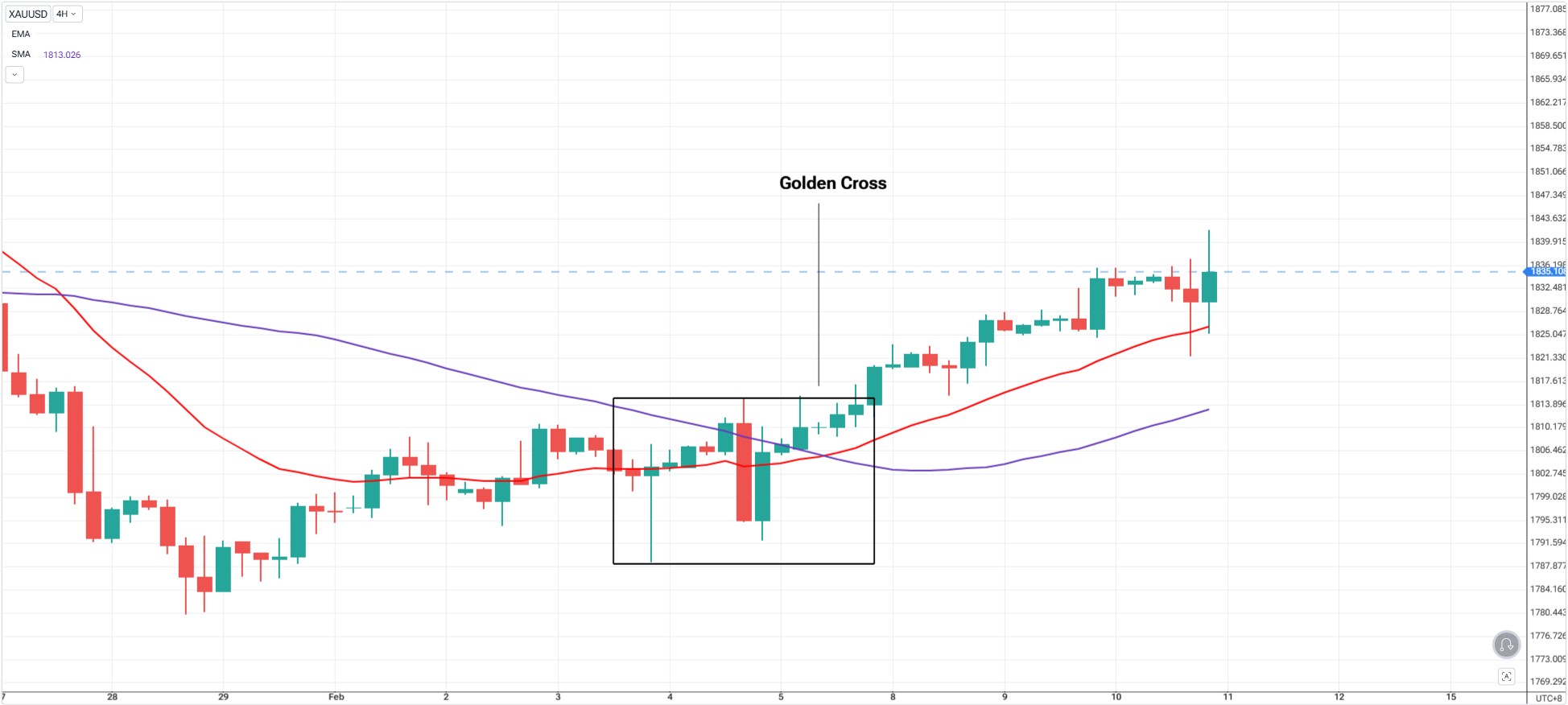
- 20 EMA gives shallow pullbacks for fast trades
- 50 SMA catches deeper mean-reversion setups
- Bonus: Look for pullback near key levels like a Fair Value Gap (FVG), Order Block (OB), or Previous High/Low.
You're not chasing breakouts — you're trading the retest.
Step 3: Trigger the Trade with LTF Golden Cross + Breakout
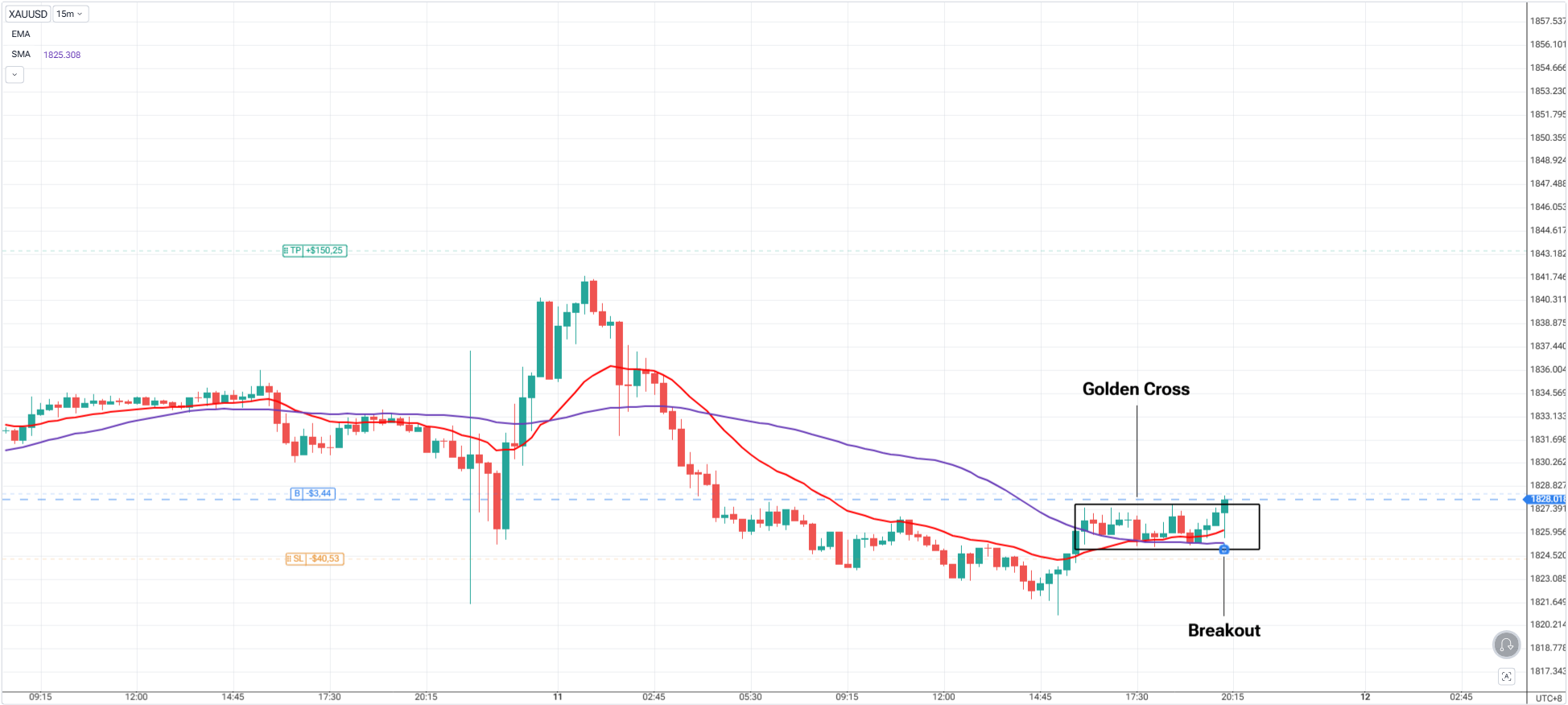
Use price action confirmation at the moving average zone:
- Bullish or bearish engulfing candle at MA
- Wick rejection with close back into trend direction
- BOS or CHoCH forming near MAs
- Liquidity sweep + strong impulse candle
Enter only on candle close that confirms direction and trend.
Stop-Loss Placement Guide
| Entry Type | Suggested Stop Placement |
|---|---|
| 20 EMA bounce | Below swing low + EMA wick |
| 50 SMA pullback | Below structure/consolidation |
| Aggressive entry | Below entry candle or FVG zone |
Trailing Your Trade: Ride the Trend with Confidence
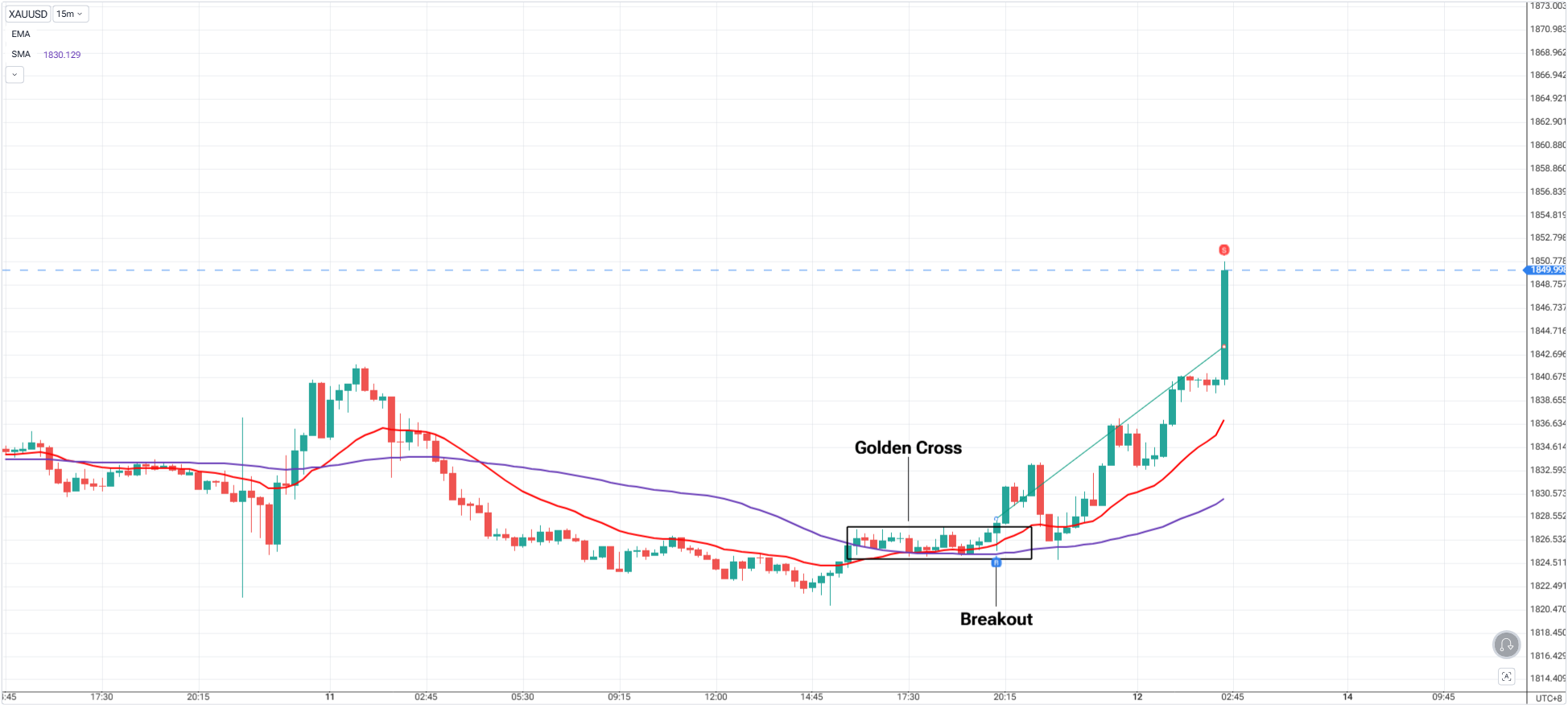
Method 1: Structure-Based Trail
- Move SL below higher lows (in uptrend)
- Move SL above lower highs (in downtrend)
- Keeps you in trade while following price structure
Method 2: EMA-Based Trail
- If price stays above 20 EMA, stay in the trade
- Exit only if:
- Price closes below 20 EMA
- A structure break confirms trend weakening
Use 50 SMA for deeper trend follow-through on swing trades.
Don’t place your stop right on the MA line — give price room to breathe.
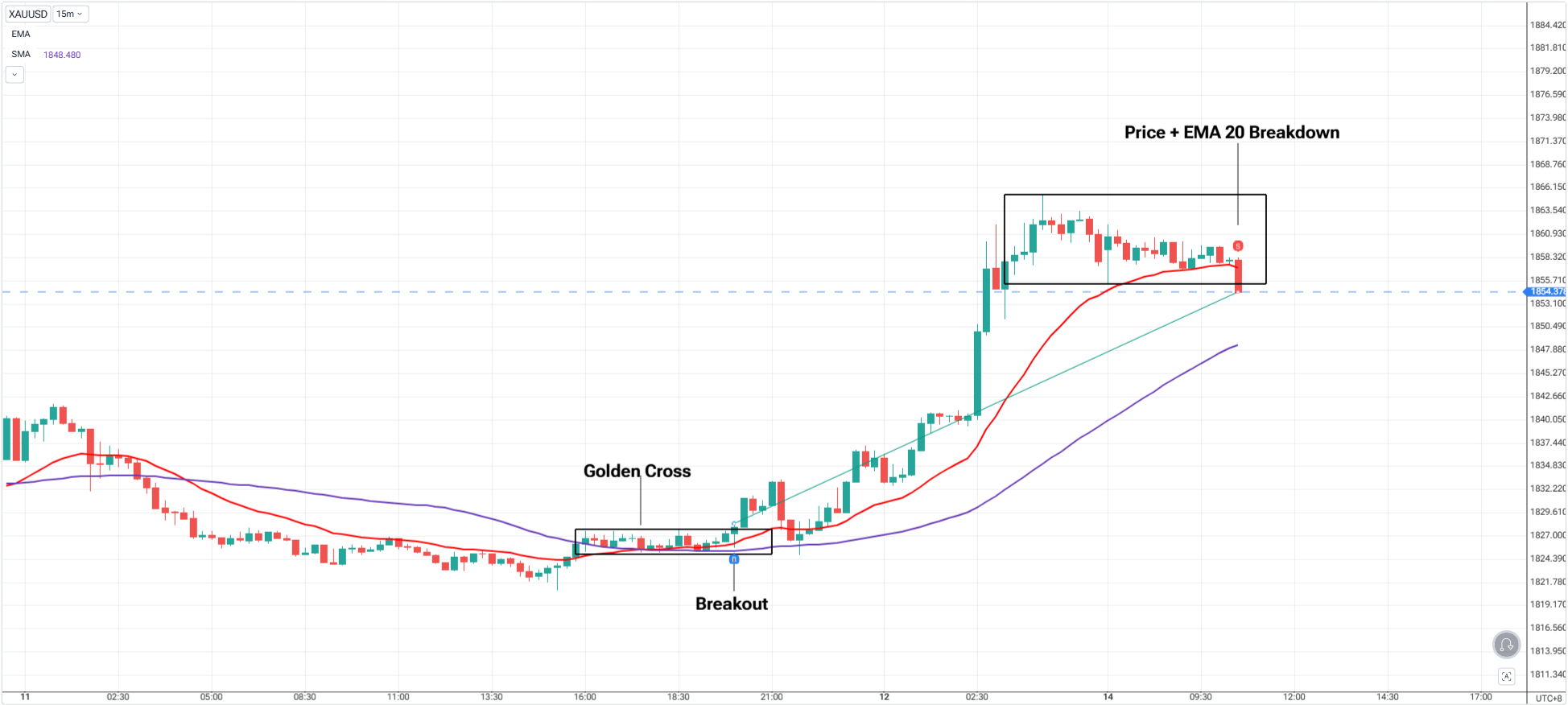
Pro Tip: You could use the Structure + EMA Trail for Stops
Real-Life Analogy: Changing Gears While Driving

Think of a moving average crossover like shifting gears in a manual car.
- A Golden Cross is like moving from 2nd to 3rd — you’ve got enough speed to push higher.
- A Death Cross is like downshifting — things are slowing down, and you need to be cautious.
Alternative Crossover Settings (Shorter-Term Variations):
| Crossover Pair | Use Case | Common Application |
|---|---|---|
| 20 EMA / 50 EMA | Swing & intraday trading | More sensitive to short/mid-term trend shifts |
| 9 EMA / 21 EMA | Momentum scalping | Reacts quickly in trending markets |
| 10 EMA / 30 EMA | Forex intraday/swing | Balanced crossover for FX pairs |
| 20 SMA / 100 EMA | Crypto / Volatile markets | Good for fast-trending markets like BTC, NASDAQ |
These alternatives are valid and often preferred in:
- Faster markets (indices, crypto, forex)
- Intraday charts (M15–H1)
- Shorter holding periods
Important Note:
- The meaning of the Golden/Death Cross stays the same: a bullish or bearish trend signal via crossover.
- The reliability depends on:
- The timeframe you use
- The volatility of the asset
- Whether you confirm with price action
When to Use 20/50 vs 50/200
| Use 20/50 When... | Use 50/200 When... |
|---|---|
| You trade actively (intra/swing) | You're holding positions for weeks/months |
| You want faster confirmation | You want slower, more stable signals |
| You trade volatile assets | You're investing in equities/indices |
| You combine with price action entries | You're building macro bias |
If you’re trading forex, crypto, or NASDAQ intraday, the 20/50 EMA crossover can be your personalized Golden Cross.
Just remember — no crossover should be traded blindly. Always pair it with:
- Structure
- Momentum candles
- Liquidity sweeps
- Break of structure (BOS/CHoCH)
When NOT to Trust MA Crossovers
- In choppy or sideways markets (MAs crisscross constantly)
- During low volatility sessions (like holidays or pre-news)
- When price is too extended above or below the MAs
Instead, combine MA crossover logic with:
- Price structure (support/resistance zones)
- Volume spikes
- Fair Value Gaps (FVGs) or order blocks
Price Action Still Comes First
Always remember:
Moving averages are delayed — they calculate based on past prices.
Price action is real-time. It’s the actual message — MAs are the echo.
Use MAs as:
Trend filters
Re-entry zones
Confirmation of structure
But rely on price structure (breaks, sweeps, BOS, CHoCH) to trigger trades.
Final Thought

Crossover signals are not magic entries — they’re visual confirmations of momentum shifts.
Used with price action triggers, structure, and multi-timeframe awareness, they become a powerful tool to stay on the right side of the trend.
The best traders don’t blindly trade the cross — they use it to confirm their directional bias and wait for clean structure-based entries.
Pair it with real price action and structure — that’s when moving averages shine.
This Week’s Challenge:
- Add 20 EMA and 50 EMA to your intraday charts
- Spot a crossover and wait for price to pull back
- Watch how price reacts around the MAs — screenshot and log the result
- Write your rules: “I enter only if [trigger] happens after the crossover”
Start Practicing with Confidence - Risk-Free!
Open a free demo account today and experience institutional-grade spreads, lightning-fast execution, and all the tools you need to grow as a trader.
- Trade forex, indices, gold, and more
- Access ACY, MT4, MT5, & Copy Trading Platforms
- Practice with zero risk
It’s time to go from theory to execution - risk-free.
Create an Account. Start Your Free Demo!
Check Out My Contents:
Strategies That You Can Use
How To Trade & Scalp Indices at the Open Using Smart Money Concepts (SMC)
How to Trade Breakouts Effectively in Day Trading with Smart Money Concepts
Complete Step-by-Step Guide to Day Trading Gold (XAU/USD) with Smart Money Concepts (SMC)
The Power of Multi-Timeframe Analysis in Smart Money Concepts (SMC)
Forex Trading Strategy for Beginners
Mastering Candlestick Pattern Analysis with the SMC Strategy for Day Trading
Mastering Risk Management: Stop Loss, Take Profit, and Position Sizing
How to Use Fibonacci to Set Targets & Stops (Complete Guide)
RSI Divergence Trading Strategy for Gold: How to Identify and Trade Trend Reversals
Stochastics Trading Secrets: How to Time Entries in Trending Markets using Stochastics
Gold Trading Stochastics Strategy: How to Trade Gold with 2R–3R Targets
RSI Hidden Divergence Explained: How to Spot Trend Continuations Like a Pro
How To Trade News
Why Smart Money Concepts Work in News-Driven Markets - CPI, NFP, and More
How to Trade NFP Using Smart Money Concepts (SMC)-A Proven Strategy for Forex Traders
How to Trade CPI Like Smart Money - A Step-by-Step Guide Using SMC
Learn How to Trade US Indices
How to Start Trading Indices and Get into the Stock Market with Low Capital (2025 Guide)
Best Indices to Trade for Day Traders | NASDAQ, S&P 500, DAX + Best Times to Trade Them
How To Trade & Scalp Indices at the Open Using Smart Money Concepts (SMC)
NAS100 - How to Trade the Nasdaq Like a Pro (Smart Money Edition)
How to Trade CPI Like Smart Money - A Step-by-Step Guide Using SMC
Why Smart Money Concepts Work in News-Driven Markets - CPI, NFP, and More
How to Start Trading Gold
How to Swing Trade Gold (XAU/USD) Using Smart Money Concepts: A Simple Guide for Traders
Complete Step-by-Step Guide to Day Trading Gold (XAU/USD) with Smart Money Concepts (SMC)
The Ultimate Guide to Backtesting and Trading Gold (XAU/USD) Using Smart Money Concepts (SMC)
Why Gold Remains the Ultimate Security in a Shifting World
How to Trade Japanese Candlesticks
How to Trade Candlestick Patterns with High Probability: A Complete Guide for Beginners
The Top Japanese Candlestick Guide: What is an Engulfing Pattern and How to Trade It?
Piercing Pattern Candlestick Explained: How to Trade It - Step-By-Step Guide
Morning & Evening Star Candlestick Patterns – How to Trade Market Reversals with Confidence
How to Start Day Trading
5 Steps to Start Day Trading: A Strategic Guide for Beginners
8 Steps How to Start Forex Day Trading in 2025: A Beginner’s Step-by-Step Guide
3 Steps to Build a Trading Routine for Consistency and Discipline - Day Trading Edition
The Ultimate Guide to Understanding Market Trends and Price Action
Trading with Momentum: The Best Trading Session to Trade Forex, Gold and Indices
Learn how to navigate yourself in times of turmoil
How to Identify Risk-On and Risk-Off Market Sentiment: A Complete Trader’s Guide
How to Trade Risk-On and Risk-Off Sentiment - With Technical Confirmation
The Ultimate Guide to Understanding Market Trends and Price Action
Want to learn how to trade like the Smart Money?
Why Smart Money Concepts Work: The Truth Behind Liquidity and Price Action
Mastering the Market with Smart Money Concepts: 5 Strategic Approaches
Mastering Candlestick Pattern Analysis with the SMC Strategy for Day Trading
Understanding Liquidity Sweep: How Smart Money Trades Liquidity Zones in Forex, Gold, US Indices
The SMC Playbook Series Part 4: How to Confirm Trend Reversal & Direction using SMC
The SMC Playbook Series Part 5: The Power of Multi-Timeframe Analysis in Smart Money Concepts (SMC)
Fair Value Gaps Explained: How Smart Money Leaves Footprints in the Market
The Best Time to Use Smart Money Concepts (SMC): Why Timing Is Everything in Trading SMC
How to Trade the London Session Using Smart Money Concepts (SMC)
Trading Psychology and Continuous Improvement Contents
The Mental Game of Execution - Debunking the Common Trading Psychology
5 Steps to Backtest a Trading Strategy with AI: A Step-by-Step Guide
Managing Trading Losses: Why You Can Be Wrong and Still Win Big in Trading
The Hidden Threat in Trading: How Performance Anxiety Sabotages Your Edge
Why You Fail in Trading: You Don’t Have Enough Capital to Survive
Why 90% of Retail Traders Fail Even with Profitable Trading Strategies
The Top 10 Best Trading Books That Changed My Mindset, Strategy & Performance
Discovering Your Trader Profile: What Kind of Trader Are You?
Follow me for more daily market insights!
Jasper Osita - LinkedIn - FXStreet - YouTube
This content may have been written by a third party. ACY makes no representation or warranty and assumes no liability as to the accuracy or completeness of the information provided, nor any loss arising from any investment based on a recommendation, forecast or other information supplies by any third-party. This content is information only, and does not constitute financial, investment or other advice on which you can rely.
Try These Next
4 Powerful Tactics to Overcome the Most Costly Forex Mistakes
How to Master MT4 & MT5 - Tips and Tricks for Traders
The Importance of Fundamental Analysis in Forex Trading
Forex Leverage Explained: Mastering Forex Leverage in Trading & Controlling Margin
The Importance of Liquidity in Forex: A Beginner's Guide
Close All Metatrader Script: Maximise Your Trading Efficiency and Reduce Stress
Best Currency Pairs To Trade in 2025
Forex Trading Hours: Finding the Best Times to Trade FX
MetaTrader Expert Advisor - The Benefits of Algorithmic Trading and Forex EAs
Top 5 Candlestick Trading Formations Every Trader Must Know















